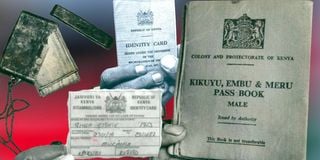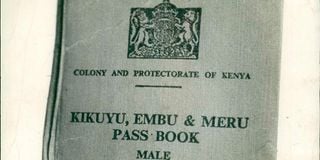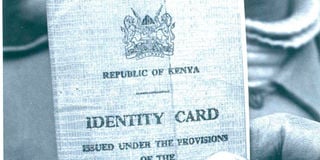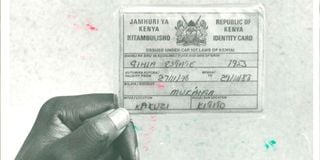IDs crisis: History of the Kenyan Identity Card

The identity cards that were used in Kenya.
What you need to know:
- The kipande determined job opportunities, and freedom of movement across the country.
Women were not issued government IDs until about four decades ago.
It was worn like a necklace with a metallic pendant when it was first rolled out in Kenya in 1915. Or like a leash on a dog.
Every man above 16 was required to dangle it around the neck. It was, basically, a bunch of documents nestled in a copper container that had a chain. Kipande was its name.
Hitherto free to roam up and down the land, the men were now supposed to demonstrate that the colonial masters “knew” them.

The identity cards that Kenyans were forced to wear around their necks during colonial times.
The kipande determined job opportunities and freedom of movement across the country.
Most hated it, to the point of enlisting in the guerrilla armies formed to eject the colonialists.
With time, the leash was shelved, giving way to the passbook. Proof of being a legitimate adult in the eyes of the government now needed to be carried in the pocket.
Women were not issued government IDs until about four decades ago.
The terror of not having the document, which is today a plastic credit-card-sized second-generation identity card, may be as blood-curdling today as it was in the colonial era.
Take the example of a bearded Kenyan with a slightly receding hairline but who does not have an ID card. Or a woman carrying a toddler.

The colonial-era passbook.
Get the picture? Someone so old as being incapable of getting away with lying that they are underage.
That person will have a hard time entering most buildings in Kenyan cities.
It is until you meet a devilishly determined, goody-two-shoes guard that you realise that your ID is most important when you don’t have it.

Identity card.
Not having an ID will see you frozen out by guards, who will demand that you call the person you need to see or go back to fetch your identification documents.
A driving licence or passport could suffice in most cases, as they are considered legal identification documents in Kenya.
Speaking of calling, that person will also not be eligible to get a mobile phone number that is truly theirs, meaning they either have to use a line registered in someone else’s name or have no line at all.
That also means M-Pesa and other mobile-based cash transfer services will be out of reach for them.
Should that person wish to open a bank account, no lender will touch them with a 10-foot pole, and it goes without saying that they will never get any kind of loan.
It is a world of KYC (know your customer) and a person without an ID has no right to be known by such institutions.
Without an ID, the person will be unemployable in most settings. Which foreman can employ a person without an ID?
Which household can take in a house help without that document?
Without the document, the job-seeker may well be considered a fugitive.

Old generation ID card.
Even the lowliest of jobs will be out of bounds for this person, not to mention registering a business. That means total economic exclusion.
Simply put, one is an alien without an ID. He or she will be in for difficult times if they cross paths with the police who will, in not-so-polite terms, want to know why that person’s fingerprints are not in the government database.
By the way, did you know that Kenyan women started getting IDs in 1978?
That means that for 59 years cutting across the colonial and post-colonial governments, only men were supposed to be “known” by the State.
Did you also know that it was not until 1980 that the age of obtaining an ID was revised from 16 to 18? It’s probably why they called it sweet 16.
In contrast, however, the British who introduced the ID system in Kenya don’t have any mandatory requirements for their citizens, while in the UK, to walk around with an identification document.
They abolished that requirement in 1951.




